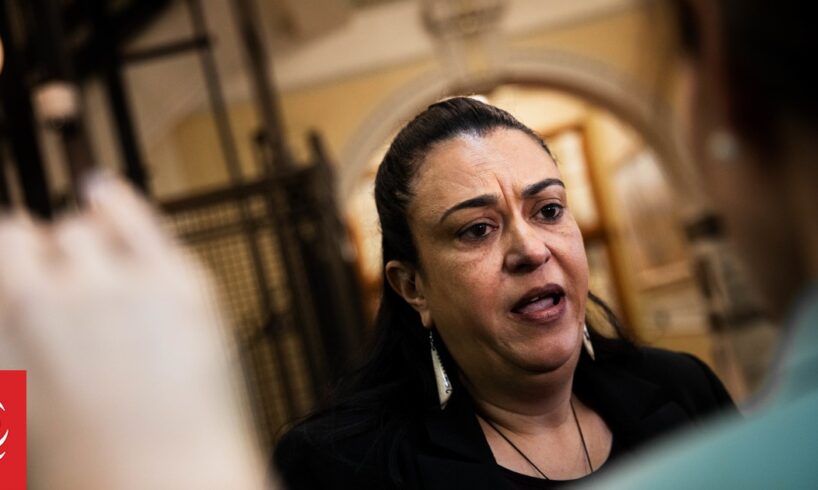
Children’s Minister Karen Chhour.
Photo: RNZ / Samuel Rillstone
Children’s Minister Karen Chhour has acknowledged her initial celebration of a reduction of harm in state care residences did not provide the full picture.
The government this week was celebrating the first recorded drop in harm in Youth Justice and Care and Protection facilities.
However, that is just one of four categories tracked by Oranga Tamariki, and the statement out on Wednesday included no mention of a 4 percent increase in recorded harm across the wider state care system.
The Children’s Commissioner and the Independent Children’s Monitor within hours had released their own statement urging a more considered assessment.
They welcomed the decrease of harm in government facilities, but noted that was just three fewer children harmed – dropping from 118 in 2024 to 115 this year. The Oranga Tamariki report the data comes from further reveals reported harm in those facilities is up from just 22 in 2021.
Children’s Commissioner Claire Achmad told RNZ it was unacceptable to see overall harm in state care had increased – with 530 reports of children harmed over the last 12 months.
“And actually there has been a higher number of findings of harm in care as well, 896 … what that tells us is that for some of these children, in fact around 21 percent, they have actually experienced multiple incidences of harm.
“We are talking about really serious harm, including physical abuse, sexual abuse, emotional abuse and neglect.”
Children’s Commissioner Claire Achmad.
Photo: RNZ / Cole Eastham-Farrelly
The categories of state care where harm is tracked include:
In non-family care: 3336 total children or young people, of whom 178 (5 percent) suffered reported harm
In the care of wider family: 2225 total, of whom 140 (6 percent) suffered reported harm
In return/remain home care (with parents): 1019 total, of whom 134 (13 percent) suffered reported harm (the highest proportion on record and which accounts for 24 percent of all harm findings this year)
In residential care (managed facilities): 503 total, of whom 115 suffered harm (23 percent)
The report all this came from states:
“Presenting the data in this way supports a deeper and more nuanced understanding of the environments where harm can occur and reflects the complexity that can arise in different care settings.
“By focusing on context and patterns we aim to support meaningful learning and improvement, rather than assigning blame, and ensure that the voices of tamariki remain central to how we interpret and respond to harm.”
Labour’s spokesperson for children, Willow Jean Prime, told RNZ the minister was playing politics.
“The minister cherry picking certain data to make a political point or score political points, is unacceptable when we see that the data in the report shows there’s actually been an overall increase in children harmed,” she said.
“These are really sensitive issues. No abuse in care is acceptable.”
Labour’s spokesperson for children Willow Jean Prime.
Photo: RNZ
The minister did acknowledge the overall increase in Parliament on Thursday.
“We must acknowledge what is working and where there is still room for improvement,” she said. “The data shows a disproportionately higher number of children and young people living in return- or remain-home placements experienced harm.”
Speaking to RNZ, she acknowledged that wider context was missing from her initial statements.
“I was focusing on residential care, because we’ve never had a decrease in residential care and harm in residential care ever. The staff have worked really, really hard to make sure that there’s a turnaround and we’re seeing a positive difference,” she said.
“I have heard that there is a concern that I’m focusing just on one area of Oranga Tamariki but what I would say is that area was underinvested in for so long that we need to actually talk about the wins.”
She argued much of the harm being experienced outside of those residence facilities was not able to be controlled by the government.
“Sixty percent of that harm actually happens out in the community – not by the caregivers, not by the person that is responsible for the children.
“That could include things like a young person going to school and getting beaten up at school … it could be a child walking to school and getting attacked by a stranger.
“That’s kind of out of the hands of Oranga Tamariki when a young person is out in the community. But what I can do is we can look at support services out in the community to prevent that that particular area of harm.”
The minister says some harm in the community is out of Oranga Tamariki’s control.
Photo: RNZ
Prime however questioned what might have led to that kind of harm.
“I want to know if the cuts to community services providers who provide wraparound services and support, social work support and so on, to children and their families has perhaps had some impact on those numbers.
“This minister has cut $30 million a year from social services in our community for prevention and early intervention work. Community providers told us that the impact of those cuts would mean that more children are harmed more.”
Chhour disputed that.
“We are still spending exactly the same amount of money. What we’ve done is we’ve actually reprioritised the areas where it is most needed – so we are spending around $500 million this year, the same amount we spent in the previous year.”
Oranga Tamariki’s annual report shows $30m was cut from the agency’s contracting spend in 2024, as part of a $45m total reduction in baseline spending.
Other trends from the report include an 8 percent decrease in physical harm. Other types of measured harm – emotional or sexual abuse, and neglect – increased, but only to levels similar to what they had been in previous years.
A reduction in harm in government facilities is worth celebrating – it is after all where the greatest proportion of harm to those in state care occurs.
Another factor worth considering though: a staggering 56 percent of those harmed in Youth Justice or Care and Protection facilities had a disability of some kind.
The increase in harm to children returning to their parents’ care was put down to “complex care histories. We also know that a significant number have a diagnosed disability which places increased pressure on their parents”.
“In some of the cases reviewed, we could see the impact of wider stressors on the care of children such as inadequate housing, children not engaged in education, and other environmental stressors that were affecting children’s wellbeing and safety.”
The report also points to a significant 44 percent increase in “reports of concern” – which can be made by members of the public to Oranga Tamariki or police.
That increase was blamed for the number of “critical” or “very urgent” reports responded to within the target times of 24 and 48 hours respectively: 86 percent, down from 92 percent last year.
People are also more likely to come forward with reports of harm than in the past, with the report identifying that “more consistent formal reporting and identification of harm in care has contributed to an increase in findings”.
Chhour has also talked up the prospect of improved facilities aiding reduced harm in managed residences.
Her claims these have been underinvested in ring true: Despite a target of having 100 percent of owned buildings with a completed WOF, this year that figure is just 11 percent, and only two-thirds of OT buildings (67 percent) were in “moderate or better” condition – the target is 90 percent.
Sign up for Ngā Pitopito Kōrero, a daily newsletter curated by our editors and delivered straight to your inbox every weekday.





